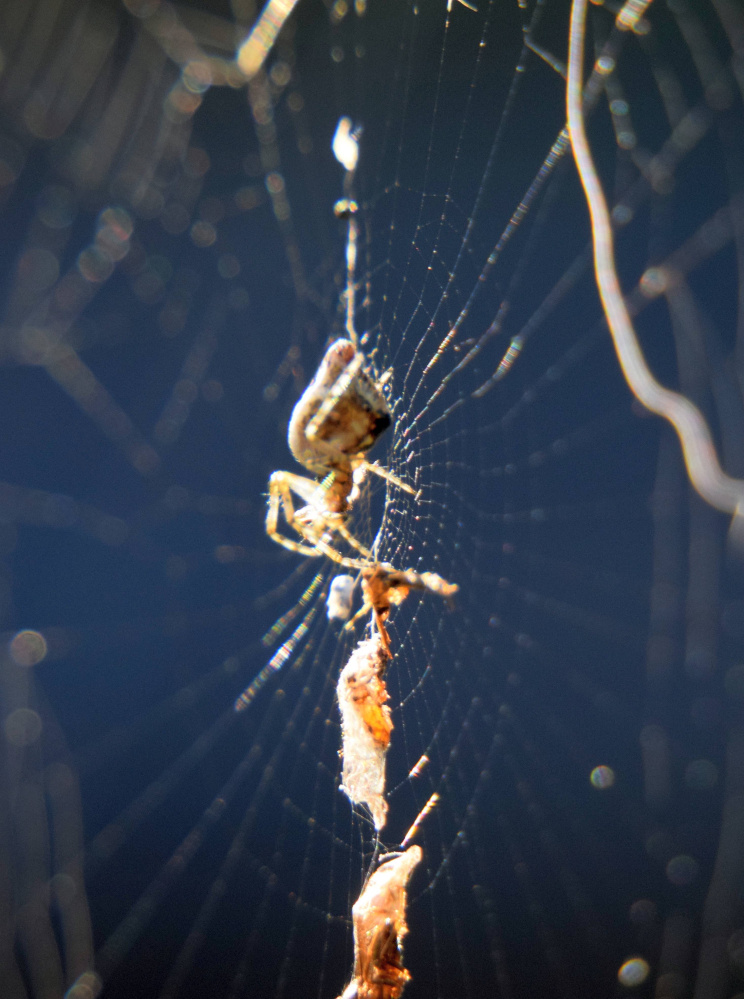FOR A WHILE I walked past the spider web under the deck railing without paying much of any attention to it. No spider was visible, and anyway, it looked old and disused, with bits and pieces of detritus in it.
Then one day the design in the web came into focus. The detritus was in a straight line through the central axis of the orb web. Still no spider in sight, but wait a minute. Is this a trash line web?
My eyes being what they are these days, I went in the house and got the high-tech LED-lighted magnifying glass Bonnie bought me as a hint, I think, but anyway. The September sunlight angling in over the trees threw a beautiful glint onto the carefully spiraled silk. How do orb-weaving spiders know the engineering for these structures?
Sure enough, the detritus was a line of carefully affixed body parts — bits of insect legs and shells, torn wings. I turned the magnifying glass on the underside of the railing, thinking the spider might be waiting on the side for the prey to get tangled up. I couldn’t see anybody, so I went back to the fascinating trash line.
Funny what you don’t see until you know how to look.
I scanned the tight-knit center, and there it was — a tiny spider, maybe 3 millimeters in body length, with similar color and shape as the other bits. I zeroed in as close as my eyes could make any sense of it. The eight little legs were folded up neatly toward the spider’s front, or cephalothorax. The abdomen appeared to have a protrusion. So I got the camera to try to get some clear shots I could blow up on a computer screen.
Long story short, this was indeed a trash line spider of the genus Cyclosa, probably the conica species, which is more likely to be seen in Maine than C. turbinata, which is similar but has two little humps on its back.
Spider researchers have no consensus on what trash lines in webs do. A number of orb-weaving spiders decorate their webs with heavy silk lines, sometimes in zigzags, sometimes central spirals, called stabilimenta. C. conica does that, but in some cases takes the decoration (a word the scientists actually use, often seeming unaware of the figurative implications) a step further and lines the web with leftovers, sometimes in a straight line like my spider, sometimes in a pattern.
The arachnologists’ best guess is that the trash provides camouflage for the spider. Different studies have found different rates of predation on spiders who use detritus camouflage. One study of a Japanese species of Cyclosa found that dummy spiders in trash line webs had substantially fewer wasp bites than dummy spiders without trash lines. On the other hand, a different study on live spiders seemed to show the opposite.
The other hypothesis about the trash lines is that they’re meant to attract prey. But again, different studies trying to find out if this is the case get different results. One study found that the trash-lined webs actually had less success attracting food items than undecorated webs.
One aspect of the uncertainty involves what predators actually see when they look at a trash-line web. I couldn’t see the spider until I got the magnifying glass out, but my vision is quite a bit different from a wasp’s or a bird’s. Many insects can see wavelengths of light that humans can’t, and spider silks reflect ultraviolet light in varying intensities. So we don’t know exactly what the web would look like to a wasp.
What it looks like to me, on the other hand, is kind of fascinating. The trash in our deck spider’s web was arranged in a very straight, evenly spaced line. An Asian species, C. confusa, arranges the trash to resemble its own size and shape, presumably as a decoy. And a few years ago, some researchers in the Peruvian Amazon stumbled across a spider (which they believe is probably a new species of Cyclosa) that constructs what amounts to a replica of itself — down to the legs, cephalothorax and abdomen — and, like C. conica, hides underneath the trash effigy.
Spiders that make art, for crying out loud. How do they know to do this? What’s happening in a spider’s mind when it carefully spins out a beautiful, symmetrical orb web, and then puts heavier threads of silk or bits and pieces of insect parts into it, like designs in a carpet? No metaphor can say.
Anyway, there’s been a little boom of Cyclosa webs around our backyard. Our deck Cyclosa’s web was there for at least a week after I first spotted it, until Bonnie usurped the spot with a paintbrush. I found another neatly hung from a deck chair and table, and another between the couch and coffee table in the living room.
One night, another web appeared between the deck railing and the side of the house. At the center was what looked like an araneid way too large to be Cyclosa. I couldn’t see it clearly in the dark.
When I got up the next morning, the web was still there. But what had looked in the dark like a large spider turned out to be a bunch of detritus in the shape of a spider, with two oblong body sections, jointed legs. I don’t know. I can only tell you the form I saw. But I can’t stop pointing to the beauty.
Dana Wilde lives in Troy. His new book “Summer to Fall” is available from North Country Press. You can contact him at naturalist1@dwildepress.net. Backyard Naturalist appears the second and fourth Thursdays each month.
Send questions/comments to the editors.




Success. Please wait for the page to reload. If the page does not reload within 5 seconds, please refresh the page.
Enter your email and password to access comments.
Hi, to comment on stories you must . This profile is in addition to your subscription and website login.
Already have a commenting profile? .
Invalid username/password.
Please check your email to confirm and complete your registration.
Only subscribers are eligible to post comments. Please subscribe or login first for digital access. Here’s why.
Use the form below to reset your password. When you've submitted your account email, we will send an email with a reset code.